#aibake
Photo
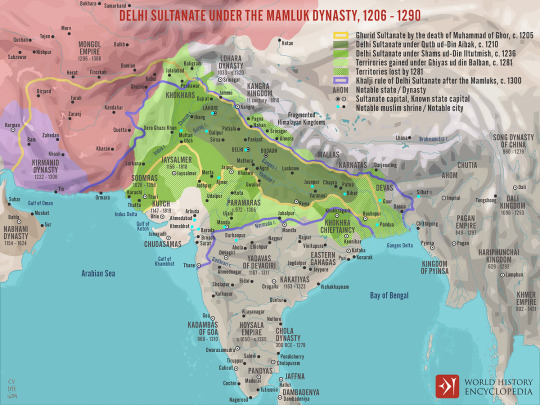
Delhi Sultanate under the Mamluk Dynasty, 1206-1290
A map illustrating the rise and evolution of the Sultanate of Delhi during the times of its first ruling dynasty – the Mamluks (also known as the Slave or Ghulam Dynasty), an influential military class of slave soldiers between 1206 and 1290. Following the assassination of the childless Muhammad bin Sam, popularly known as Muhammad of Ghor, in 1206, the Ghurid Sultanate shattered into minor kingdoms ruled by Mamluk commanders. The appointed governor of the Indian territories, Qutb ud-Din Aibak, a Turkic slave general, became the ruler of what was to become the Sultanate of Delhi. Through its turbulent history (until 1526, when the invasion of Babur swept it aside, the Sultanate was ruled by five unrelated dynasties), multiple autonomous states challenged the influence and control of the Delhi Sultanate in the fertile lands between the rivers Ganga and Jamuna, which was reflected in its ebbing and ever-changing frontiers.
Image by Simeon Netchev
39 notes
·
View notes
Text
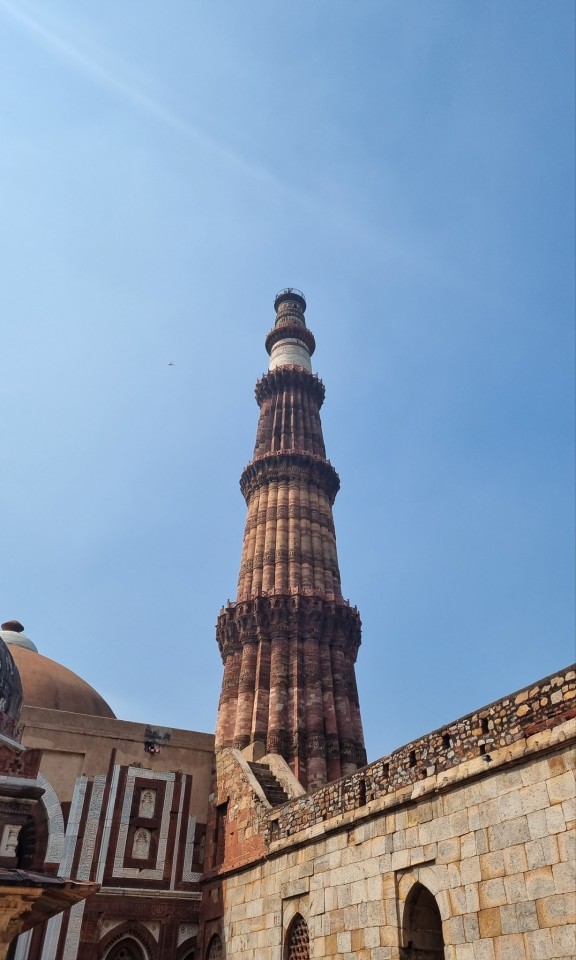
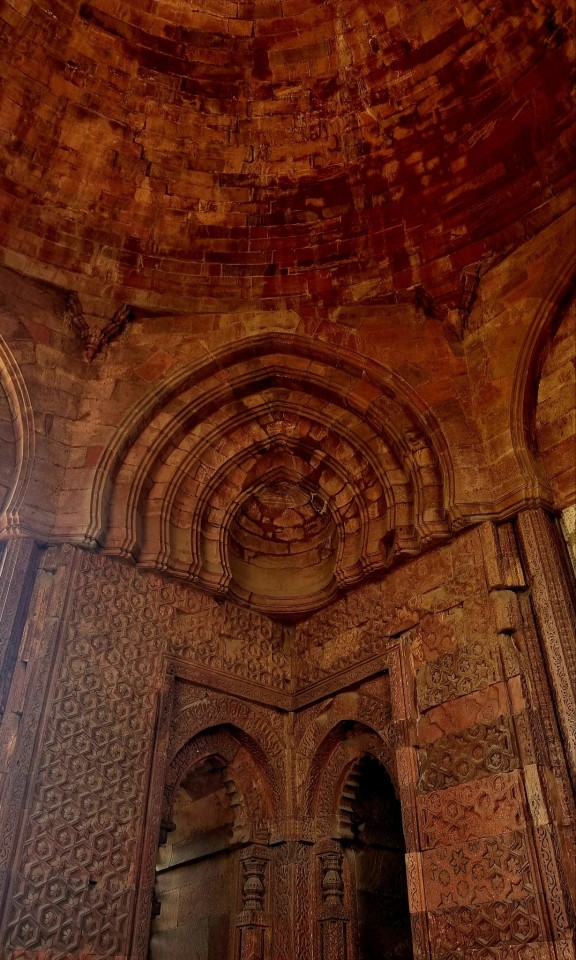
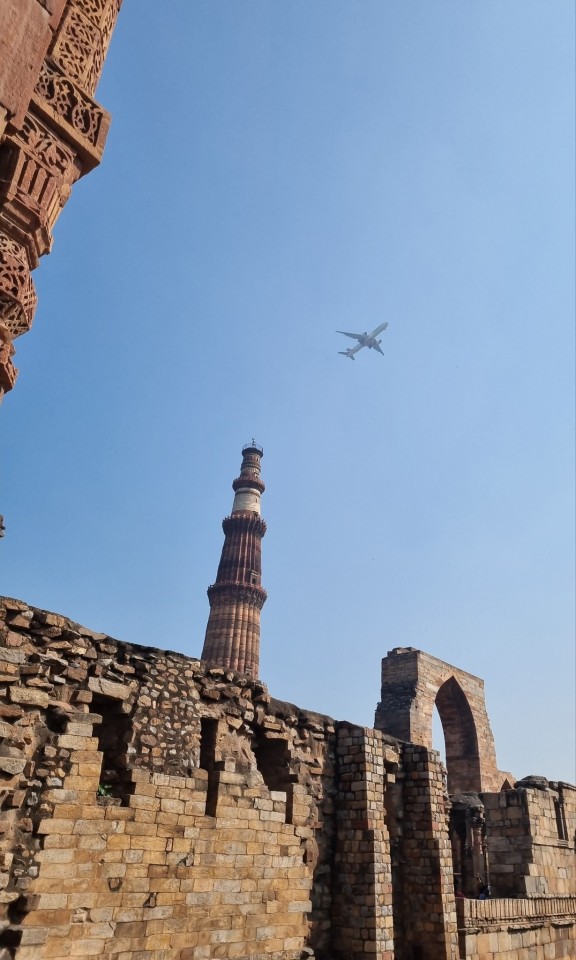
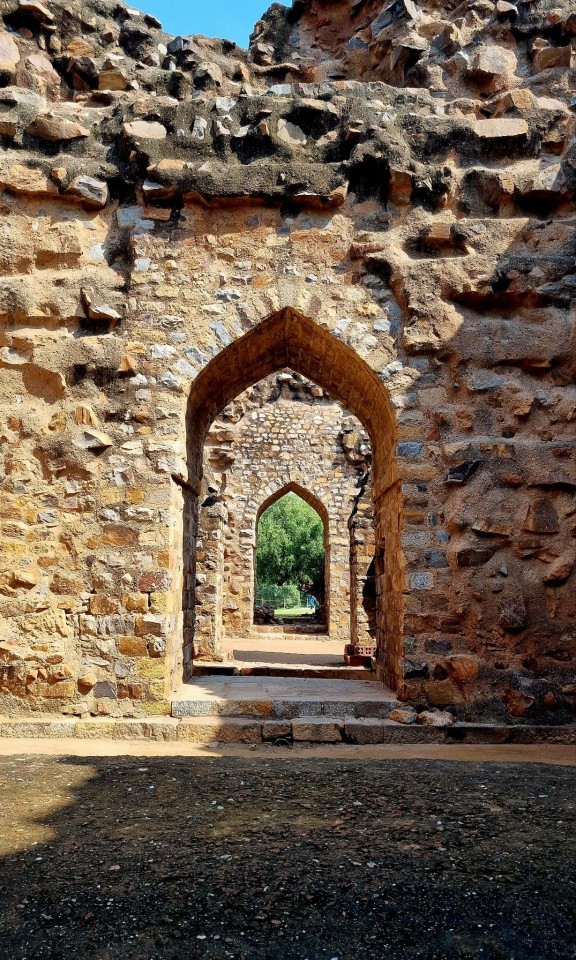
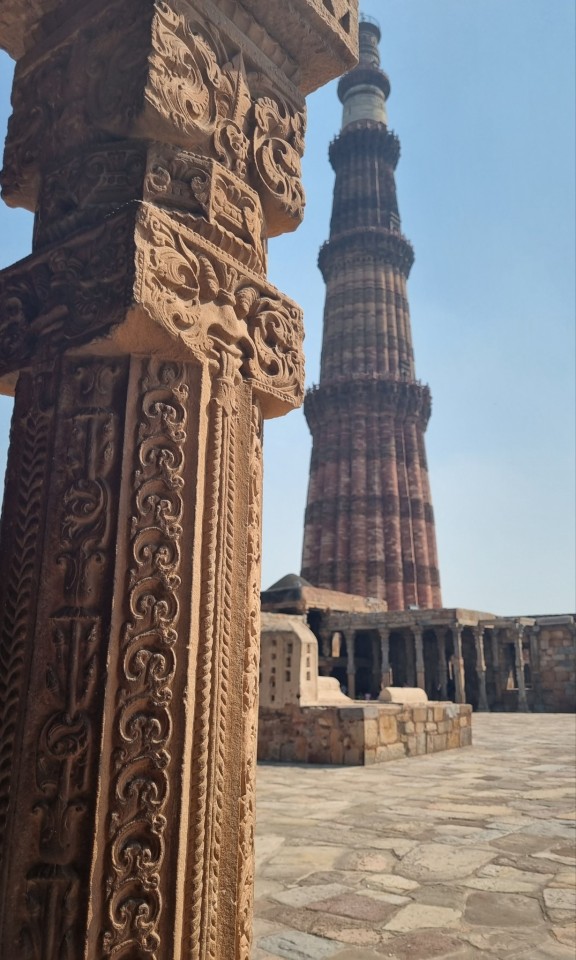


Please like or repost if downloading. Please give credit if you're sharing it online.
#qutub minar#history#monuments#dilli#delhi#new delhi#india#cultural#asia#delhi sultanate#mughals#mehrauli#qutub complex#indo islamic architecture#qutb ud din aibak#iltutmish#tughlaq dynasty#lodi dynasty#wallpaper#historical wallpapers#phone wallpapers#indian monuments#historical monuments#for you#trending#tumblr
8 notes
·
View notes
Text
Qutab Minar, New Delhi.
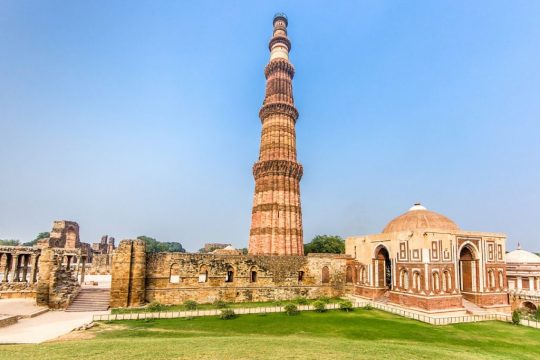
Qutab Minar or “Tower of Victory” 73 m-high tower of victory was built-in 1193 by Qutab-ud-din Aibak. Quwwat-ul-Islam Mosque was the first mosque was built next to it.
Mughal Architecture are famous world wide, but are those really Mughal architecture or stolen pieces from the indigenous people that lived there, that were subjected to slavery and unspeakable tyranny?
Quwwat-ul-Islam Mosque was built by pieces and carvings of 27 destroyed Hindu temples, as it is stated clearly below -

As it is a known fact that Mughals destroyed approximately 40,000 Hindu and Jain temples during their ~300 years of invasion in India.
There are many deities in the complex that are placed in the most disrespectful way. It is not a doubt that this complex, the minar especially was to mock the Hindus that it belonged to. There is carvings of Cows, a holy and sacred animal in Hinduism, that can be seen in many Hindu temples to this day, but not in any mosque whatsoever.
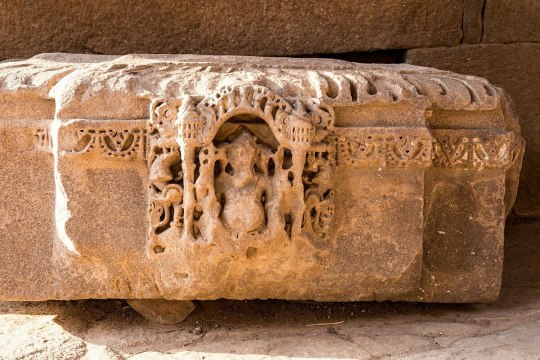
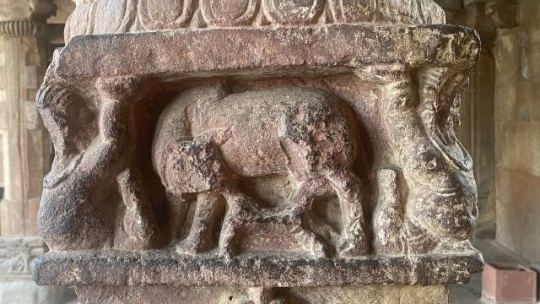
According to Islam, The bell being instrument of Satan, yet there are carvings on pillars of Bells - an instrument that is widely and always used in Hindu Practices.
There are Brahmi and Sanskrit inscriptions found in various spots in the pillar and around the complex.

So what Exactly was Qutab Minar.
The township adjoining the Kutub Minar is known as Mehrauli. That is a Sanskrit word Mihira-awali. It signifies the town- ship where the well known astronomer Mihira of Vikramaditya's court lived along with his helpers, mathematicians and technicians. They used the so-called Kutub tower as an observation post for astronomical study. Around the tower were pavilions dedicated to the 27 constellations of the Hindu Zodiac.
The Hindu title of the tower was Vishnu Dhwaj (i.e. Vishnu’s standard) alias Vishnu Stambh alias Dhruv Stambh (i.e., a polar pillar) obviously connoting an astronomical observation tower.
The Sanskrit inscription in Brahmi script on the non-rusting iron pillar close by proclaims that the lofty standard of Vishnu was raised on the hillock named Vishnupad Giri. That description indicates that a statue of the reclining Vishnu initiating the creation was consecrated in the central shrine there which was ravaged by Mohammad Ghori and his henchman Qutubuddin.
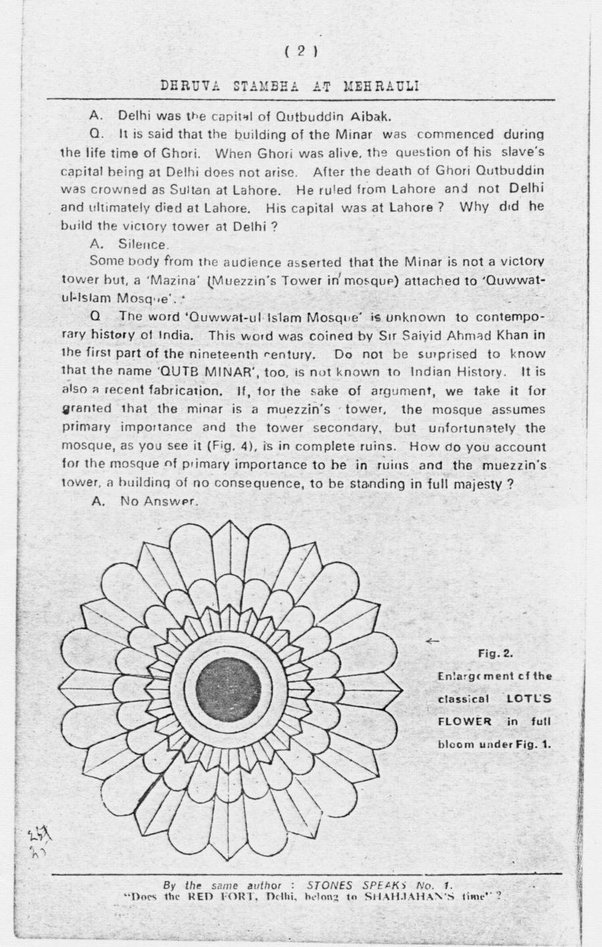
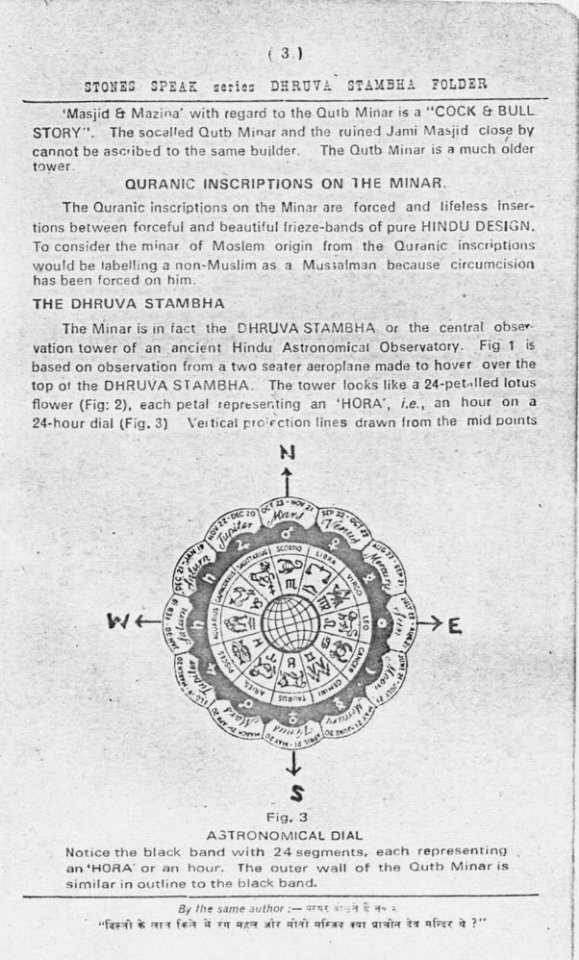
Presence of lotus flowers on the minar’s inscriptions. Lotus flowers do not feature in any Islamic structures of that era. Lotus flower buds have been covered with verses from the Quran. Lotus flowers if we observe are seen in Hindu temples.
Know your history.
धर्मो रक्षति रक्षितः
#qutab minar#mughal architecture#hinduism#hinduphobia#sanatan dharma#indian architecture#india#bharat#pseudo secularism#new delhi#mughal invasion#ancient india#colonization#hindublr#desiblr
34 notes
·
View notes
Text
Saifuddin Quthuz Sang Ksatria Perang 'Ain Jalut
Dia adalah seorang pahlawan besar dari Dinasti Mamalik. Beliau hidup di zaman runtuhnya Khalifah Abbassiyah karena serangan pasukan Tartar (Mongol).
Saifuddin Quthuz adalah pahlawan yang telah meruntuhkan dominasi Tartar di negeri Syam. Dia membalas luka akibat kekalahan kaum Muslimin di tangan Tartar, dan sekaligus membuka jalan bagi runtuhnya invansi Tartar di negeri-negeri Muslim.
Tetapi ironisnya, Saifuddin Quthuz wafat terbunuh justru oleh penguasa Muslim lain yang haus kekuasaan yaitu Baibars. Dia menjadi pemimpin Muslim sebagai Sultan Mamamik di Mesir, namun kisah perjuangan beliau sangat membekas bagi sejarah Islam
Bisa dikatakan, Saifuddin Quthuz rahimahullah adalah pahlawan Islam dan Penguasa Muslim yang terzhalimi.
Perjalan Hidup Saifuddin Quthuz
Mengenal sedikit perjalanan hidup beliau; bernama asli Mahmud bin Mahmud bin Khawarizmi. Di kenal dengan nama Saifuddin Quthuz karena semasa kecil pernah dijual sebagai budak ketika Kakeknya Khawarizmi Syah mengalami kekalahan perang atas pasukan Tartar.
Kakeknya Mahmud bin Mahmud, Khawarizmi khan, seorang raja di wilayah Khawarizmi.
Kakeknya, Khawarizmi syah dari memang dari dulu telah memiliki sejarah pertempuran dengan pasukan Jengsi Khan atau Tartar. Dimana saat Khawarizmi jatuh ke tangan Tartar, anak-anak bangsawan tangkap, termasuk Mahmud bin Mahmud atau Saifuddin Quthuz. Mereka lalu di jual sebagai budak di pasar Damaskus. Dipasar itulah dia mendapatkan panggilan Quthuz.
Kisah menarik terjadi semasa ia menjadi budak, ia di siksa oleh tuannya dan bapak serta kakeknya di maki-maki dengan perkataan yang membuatbia menangis dan mogok makan.
Ketika ditanya tentang ras sakit karena pukulan dari tuannya? Dia menjawab tidak. Dia menangis karena ayah dan kakeknya dimaki, padahal ayah dan kakeknya lebih mulia dari dirinya dan apalagi tuannya.
Ditanya kembali tentang ayahnya apakah seoarang kafir? Dia menjawab, "Tidak, aku adalah seorang Muslim dsn anak seorang Muslim. Aku adalah Mahmud bin Mahmud. Aku adalah anak anak laki-laki dari saudara perempuan Khawarizmi Syah. Aku adalah anak raja".
Orang-orang disekitar yang mendengar berubah sikap terhadap Quthuz. Di kemudian hari dia menjadi pejabat pemimpin Dinasti Ayyubiah, Izzudin Aibak.
Dalam cerita lain, Saifuddin Quthuz semasa kecil bermimpi bertemu Rasulullah. Dalam mimpi itu Nabi berpesan bahwa dia akan menjadi penguasa Mesir dan menghancurkan bangsa Tartar. Mimpi itu seperti menjadi sebuah pelita yang menuntun Saifuddin Quthuz untuk mewujudkan misi besar yaitu Meruntuhkan Tartar.
Dan hal itu benar-benar terwujud, dengan pertolongan dan Barakah Allah Al Karim.
Dengan proses yang panjang penuh liku, Saifuddin Quthuz berhasil menjadi Sultan Dinasti Mamalik di Mesir. Setelah berkuasa, dia segera mengumpulkan para amir, panglima, pemuka agama, dan para cendikiawan.
Ia berbicara dengan lantang dan penuh keberanian tentang misi yang diembannya : "Aku tidak punya maksud apapun, kecuali agar kita bersatu untuk memerangi Tartar. Hal itu tidak akan terlaksana jika tidak ada seorang pemimpin Ketika kita telah keluar dan berhasil menghancurkan musuh, maka masalah kekuasaan aku serahkan kepada kalian. Pilihlah orang yang kalian kehendaki sebagai pemimpin kalian. "Kata-kata ini menunjukkan bahwa Saifuddin Quthuz tidak berambisi kekuasaan dan kata-katanya berhasil menaril simpati para pejabat dan penguasa Muslim
Pada masa itu sebelum misi Jihad dilaksanakan, Saifuddin Quthuz meminta pertimbangan ulama di masa itu, Izuddin Bin Abdussalam. Dia bertanya tentang ide menarik pajak dari rakyat untuk membiayai jihad. Untuk melakukan sesuatu yang besar maka perlu banyak pertimbangan untuk melangkah dan pengorbanan yang tidak membuat rakyatnya menjadi lemah.
Pada masa itu rakyat tidak dipungut pajak apapun, selain Zakat. Izzudin menjelaskan, kalau negara diserang musuh, sementara Baitul Maal tak punya sedikitpun; boleh mengambil pajak dari rakyat. Tetapi lebih baik jika para panglima menjual peralatan atau barang yang mereka miliki, hanya disisakan muda dan senjata. Dengan demikian, biaya Jihad tetap terpenuhi, sedang harta rakyat tidak terganggu. Jika apra pejabat masih memilik harta atau peralatan, maka mengambil pajak dsri rakyat tidak diperbolehkan. Pendapat ini diterima dan dijalankan oleh Saifuddin Quthuz, sekaligus menunjukkan sikap hormatnya terhadap ulama.
Ketika Saifuddin Quthuz sedang mempersiapkan pasukan dan senjata, datang utusan Hulagu Khan menghadapnya dengan membawa surat yang berisikan ancaman agar Quthuz dan pasukannya menyerah, sehignga Mesir dapat dikuasai Tartar. Pejabat mesir yang mendengar isi surat menjadi ketakutan. Ada yang menyarankan agar Quthuz menyerahkan diri.
Dengan lantang Quthuz berkata : "Aku akan menghadapi Tartar sendirian, wahai para pemimpin kaum Muslimin. Kalian makan dari harta Baitul Maal, tapi kalian taku berperang. Aku akan mengahadapi mereka sendirian. Siapa yang memilih berjihad, dia bisa menemaniku dan siapa yang tidak mau, silahkan kembali ke rumahnya, sesungguhnya Allah melihatnya."
Kemudian Quthuz berdiri sambil berseru, "Wahai pemimpin kaum Muslimin, siapakah yang akan membela Islam, kalau bukan kita? " Dia berkata sambil menangis, sehingga membakar semangat para komandan dan pejabat Muslim. Mereka bertekad mengalahkan Tartar, berapapun harga yang mesti dibayar. Sebagai simbol keberanian dan tekad, Saifuddin membunuh para utusan Tartar dan menyisakan satu orang untuk menyampaikan pesan kepada pemimpin mereka. Seoalh mengatakan "Kami tidak takut dengan ancamanmu! Bahkan kami akan menghinakanmi seperti nasib para tawanan ini! "
Perang di Mulai
Tepat pada tanggal 25 Ramadhan 658 H bertemulah dua pasukan pesar ini di wilayah Ain Jalut, Palestina. Saifuddin Quthuz rahimahullah ausa'a rahmah, memimpin sendiri pasukan mujahidin Islam menghadapi kaum paganis Tartar.
Pertempuran Dahsyat terjadi, ribuan kaum muslimin gugur begitu juga Tartar. Setelah Tartar merajalela di negeri-negeri Muslim, mereka tidak pernah menyangka akan menghadapi barisan manusia-manusia Tauhid yang bermental baja, bersemangat tinggi dan berambisi meruntuhkan dominasi mereka.
Pada mulanya Pasukan Islam Terdesak disisi sebelau kiri, salah satu bidikan musuh berhasil mengenak kuda Quthuz hingga mati. Iapun melompat dari kuda dan berperang dengan jalan kaki.
Seorang amir datang dan menawarkan kuda kepadanya, sebagai ganti kuda yang telah terbunuh. Tapi Quthuz menolak. Dia tetap memilih jalan kaki. Sebagai komandan pasukan mencela sikap Quthuz itu dan mengatakan bahwa Ia akan terbunuh dan Islam akan binasa.
Dengan hati tegar Saifuddin Quthuz berkata "Jika aku mati, maka aku akan pergi ke surga, sedangkan Islam ini memiliki Rabb yang tidak akan menyia-nyiakannya.
Seperti terbunuhnya orang ini dan itu... Bahkan para pemimpin seperti Umar, Ustman dsn Ali. Lalu Allah kirimkan orang-orang selainn mereka untuk menjaga Islam ini, dan orang itu tidak akan menyia-nyiakan Islam"
Hasil Perang Ain Jalut
Saifuddin Quthuz berhasil menumpas kaum Tartar dari bumi Syam, sehingga seluruh wilayah terbebaskan dari mereka. Dia berhasil menyatukan Syam dan Mesir dibawah Dinasti Mamalik, setelah keduanya terpisahkan sejak wafatnya Sultan Shalih Najmuddin Ayyub. Bagi kaum Muslimim kemenangan di Ain Jalut meninggikan moral mereka, bahwa kaum Muslimin bisa meruntuhkan kekuatan Tartar secara telak.
Dari mata kaum Tartar, kekalahan di Ain Jalut menimbulkan trauma sejarah dan kekalahan moral sangat dahsyat. Mereka tak pernah mengira, bahwa ada bangsa lain yang sanggup memporak-porandakan kekuatannya.
Sejak saat itu bangsa Tartar terpecah belah ada sebagai masuk Islam, sebagian mundur ke India dan mendirikan kerajaan Islam Moghul, sebagian lagi pulang ke kampung halamannya.
Ain Jalut mengobati luka Kaum Muslimin akibatkan runtuhnya Khalifah Abbassiyah di Baghdad. Dan pahlawan besar di balik kemenangan ini adalah Saifuddin Quthuz.
Setelah kemenangan di Ain Jalut, Kaum Muslim berbangga dengan saifuddin Quthuz dan memuliakan Sultan yang pemberani ini.
Kematian Saifuddin Quthuz
Saat hendak pulang ke Mesir, Saifuddin Quthuz dibunuh oleh penguasa Muslim lainnya. Padahal dia sudah bertekad untuk mundur dari kekuasaannya dan menempuh jalan Zuhud.
"Sekali berarti, sesudah itu mati", ungkap seorsng penyair tentang Kisah Hidut Saifuddin Quthuz. Masa kekuasaannya pendek, hanya satu tahun, tetapi artinya sangat besar bagi kaum Muslimin.
--------------------------
Bila dicermati, kisah Hidup Mahmud bin Mahmud Al Khawarizmk atau Saifuddin Quthuz, seperti kisah Nabi Yusuf. Pada awalnya dia hidup terhormat sebagai anak raja, kemudian dijual-belikan sebagai budak, lalu dibeli seorang penguasa. Penguasa itu mendidiknya sehingga menjadi manusia besar.
Jika Yusuf bin Ya'qub berjasa membebaskan rakyat Mesir dari ancaman Kelaparan, Maka Mahmud bin Mahmud membawa pasukan Islam di Mesir untuk meruntuhkan dominasi Tartar. Dan kedua-duanya terinspirasi oleh mimpi unik di masa kecil.
Benar kata seorang dai besar asal Mesir, Syaikh Hasan Al Banna "Impian hari ini adalah kenyataan di hari esok"
-Abubua
5 notes
·
View notes
Text
Indian History
The heading might seem like a monologue to most people but Indian history is one of the topics close to my heart and it makes me hold my head high to belong to a country with such magnificent heritage. Despite being a student of Science, I’ve always felt a connection with the subject which always motivates me to peruse books and get an even bigger glimpse into the world of kings and queens, of artists and magicians, a time when people lived without the technology which has become an imminent part of the modern world today, a time when music had the power to bring rain, a time when bullock carts were the only transport available to man and a time when splendour reigned our country, the time when India was called ‘The Golden Bird’. The real reason why I'm writing this is because I feel that history is highly underrated and is a victim of generations of hatred, with literally every student crying tears of frustration as they try to memorize the names and dates on the last day of the exams, cramming everything into their minds and just writing it all out on the exam sheet, never to think of it again. But the fact remains that history is not just mugging up books as we picture when we hear the word- it’s way more than that. History is not just a subject, it's a reminder of all the great deeds that our ancestors have done, of where our roots come from and a constant lesson to us that no matter how tough things seem, there's always a solution- you just have to look for it. It all started with the Rigveda, the oldest, most pure age of ancient history when women were given an equal status to men, their activities were not constantly frowned upon and when God was worshipped with actual devotedness and not just for our selfish benefits as it is today. Following it, was the Yajurveda, then the Samaveda and finally the Atharvaveda. As the civilisations came to pass, we find that the stature of women in society continued to deteriorate before finally reducing this irreplaceable half of the society as slaves of their counterparts. Harappan and Indus Valley Civilizations have left a lasting mark on our country as we find out how intelligent and broad minded the people of those times were- the ruins a symbol of a fallen legacy. The Mauryan Empire was next up as it started the trend of conquering kingdoms and having kings and queens with Chandragupta Maurya as the founder, one of the greatest rulers India has known. The Magadha dynasty brought with it the ideas of provinces and states, of efficient management and luxurious royal lifestyle, making it one of the most remembered dynasties that we have had. The South saw its own share of royal ages as it was ruled by the Cholas, the Cheras and the Pandyas. The Gupta empire came into being soon after, one of the most ancient and prosperous ages of the country's empires. Delhi soon became a vital city of attraction for conquerers all over the world as the Delhi Sultanate was founded by Qutubuddin Aibak beginning with the Slave Dynasty, then the Khilji Dynasty, Tughlaq, Sayyid and Lodi dynasties ending only when Babur defeated Ibrahim Lodi and took on the throne of Delhi. The ever powerful Mughals then ruled Indian for many years, with Babur followed by Humayun, Akbar, Jahangir, Shah Jahan and Aurangzeb. The Mughal empire deteriorated after Aurangzeb and their mighty legacy ended with the death of Bahadur Shah Zafar at the hands of the British. The British ruled us for 150 years or so which saw some of the most challenging and revolting events in Indian history including the Partition of India, the formation of the Indian National Congress, the revolt of 1857 and expulsion of the British from India in 1947. From then onwards, India has been her own master and has flourished through hurdles and disappointments. It is my pride to have had a chance to read about our beautiful and ever inspiring culture and even more to be able to bring it out in words for you all. Its not just something to be proud of, it belongs to me and to every Indian who has the honour of being born on this soil.
4 notes
·
View notes
Photo
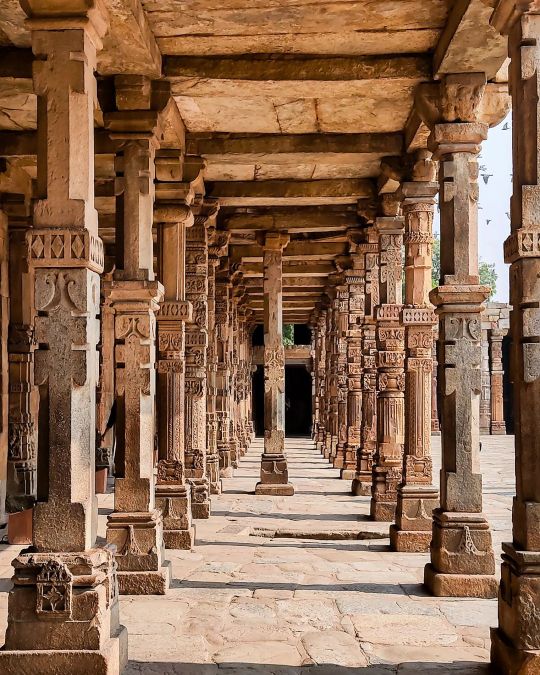
Carved pillar passage Qutub Complex The Indian Slave Dynasty (Mamluk Dynasty) lasted from 1206 to 1290, almost a century. The list of sultans is as follows Qutb ud-Din Aibak (1206 – 1210 AD) Aram shah (1210 – 1211 AD) Iltutmish (1211 – 1236 AD) Rukn-ud-din-Firoz (1236 AD) Razia al-Din (1236 – 1240 AD) Muiz-ud-din Bahram (1240 – 1242 AD) Ala-ud-din Masud (1242 – 1246 AD) Nasir-ud-din Mahmud (1246 – 1266 AD) Ghiyas-ud-din Balban (1266 – 1285 AD) Muiz-ud-din Muhammad Qaiqabad (1286 – 1290 AD) #qutubminar #delhi #worldheritagesite #history #carving #stonestructures #stonecarving #historyofindia #slavedynasty #lalkot #qutubcomplex #window #ancientmarvels #india #phonephotography #photography #mumbai #maharashtra #redsandstone #marble #delhidiaries #quwwatulislammosque # (at Qutub Minar) https://www.instagram.com/p/Cl2wjWHykQV/?igshid=NGJjMDIxMWI=
#qutubminar#delhi#worldheritagesite#history#carving#stonestructures#stonecarving#historyofindia#slavedynasty#lalkot#qutubcomplex#window#ancientmarvels#india#phonephotography#photography#mumbai#maharashtra#redsandstone#marble#delhidiaries#quwwatulislammosque
3 notes
·
View notes
Text
Blog 1- This is Delhi, The chaotic wonderland (Part 1)
Shambhavi Somvanshi

Delhi, also known as the city of Indra, is located in India. It is the capital of the country and the heart and soul of Indian civilization.
I was 7 when I visited the capital city for the first time. I had been living in Gurgaon, which is around 35 Km from Delhi, but had never been there until a school project came my way. The topic of the project was, " Write about your latest travel experience and paste pictures of the same."
So here was the perfect opportunity for me!
Got all dolled up, I was wearing a colorful jumpsuit with open hair and pink barbie sunglasses. My mother was wearing a green chikankari kurta with a pair of jeans.
We reached the MG Road metro station.
The station was gigantic, with passengers moving all over the place in order to board their respective trains.
The gray colored trains were gorgeous from inside. With separate sections for males and females, they had huge windows and displays. There were also announcements being made in soothing male and female voices about the upcoming stations.
We boarded the one that would take us to Qutub Minar.
It took us 19 minutes in crossing 8 stations and reaching our final destination, Qutub Minar.The world's tallest brick minaret , what a beauty it was!

The 238 Ft. monument, made of sandstone and marble, was such a endearing site for the sore eyes.
The tourist guide told us that the Qutub Minar was built by Qutub-ud-Din Aibak in 1193. It is also known as victory tower because it was made in order to celebrate the Muslim dominance in Hindu ruler's defeat.
I was completely in awe of it. I spent my time capturing the monument and adoring its beauty. That sequence was amazing even to me as a youngster.
I observed my surroundings. There were ice cream, popcorn , small games, binoculars , balloons being sold at the periphery of the entrance gate. There were kids who were wanting to play the games and the famous cola flavored ice cream and their parents, who were giving them the money for the same.
There were thousands of people around me,knocking into me, but I didn't care because I couldn't hear any of the commotion around me. I was utterly mesmerised by Qutub Minar; that is its allure and its enchantment.
We stayed there for around 45 minutes. The monument was also surrounded by a beautiful garden and several other historical monuments.
We sat in the garden where me and mom sat together and talked about the monument, my friends and my school.
It was now time to move to our next destination. Wondering what our next destination was? I would be sharing about it in my next blog. Please stay tuned!
#travel#architecture#culture#vacation#india gate#red fort#chandni chowk#food#qutub minar#delhi news#delhincr
5 notes
·
View notes
Text
Urdu isnt hindi, urdu is older and hindi formed out of urdu
Urdu origin is without a doubt within the military camps of Mahmud of Ghazni. This is not up for discussion. Its literally in the name. Urdu meaning "camp" in Turkic languages. This is also referenced in "Alberuni's India", translated by German Orientalist E. C. Sachau, vol.ii, p.253-258 which clearly states that the origin of Urdu was in the Ghaznavid camps.
Mahmud, a Persianised Turkic Sultan who founded the Ghaznavid empire led a mixed Persian-Turkic army which was mainly Dari (Persian) speaking.
Mahmud attacked and captured Punjab around year 1000 AD (then referred to as Lahore and Multan in sources). This would be the only region that he annexed. All other regions that he attacked were plundered and left in the hands of Hindu and Buddhist vassals. He settled his army of occupation in Lahore.
Mahmud`s descendants held the Punjab for almost 200 years before they were attacked from their east by Muhammad Ghori who had already sacked Ghazni and it wasnt until year 1193 AD that Ghoris chief general, Qutb-ud-Din Aibak took Delhi.
Let that sink in. Mahmud of Ghazni never occupied Delhi. But Urdu emerged from Ghaznavids camps over a two hundred year period that his forces occupied Punjab. Then under what pretense could anyone claim that Urdu emerged in Ganga?
However, this is not to say that Delhi did not have an influence on Urdu. We are not shameless insecure liars so lets continue this history lesson. Like any language Urdu evolved with time. Ghaznavids forces were merged with Ghoris forces because he simply didn't trust leaving his former enemy army behind as he took on Delhi. The combined army occupied Delhi and introduced early Urdu to modern day India. But just as in Punjab, the forces encountered a local dialect called Khari Boli. This would influence Urdu and Mughals would introduce more dialects so the idea that Delhi influenced Urdu is certainly true. But the origin of Urdu is without a doubt the Ghaznavid Military camps before Lahore or Delhi come into the picture.
Throughout this timeline Urdu was referred to as Hindustani, Hindvi, Zaban-e-Urdu, Zaban-e Urdu-e Mualla etc.
Modern Hindi was derived from Urdu in the 19th century, so that misnomer has no effect on the history of Urdu.
Hope that clears up any confusion you might have had.

#urdu aesthetic#urdu stuff#hindi news#india#hindi#pakistan#pakistani#history#ancient history#Pakistani history
2 notes
·
View notes
Text
Delhi City Tour

Delhi, the capital city of India, is a vibrant tapestry of contrasts, where ancient monuments coexist with bustling markets, and serene gardens offer a respite from the city’s relentless pace. A tour of Delhi is not just a sightseeing trip but a journey through time, showcasing the evolution of Indian history, culture, and urbanization. This blog will take you through a comprehensive of Delhi City Tour, highlighting its key attractions and the unique experiences it offers.
A Glimpse into Delhi’s Historical Legacy
1. Red Fort (Lal Qila)
Our journey begins at the iconic Red Fort, a UNESCO World Heritage Site and a symbol of India’s rich history. Constructed in 1638 by the Mughal Emperor Shah Jahan, the Red Fort stands as a testament to the grandeur of Mughal architecture. The massive red sandstone walls enclose a complex of palaces, gardens, and museums. The fort’s most notable features include the Diwan-i-Aam (Hall of Public Audience), Diwan-i-Khas (Hall of Private Audience), and the stunning Rang Mahal (Palace of Colors).
2. Qutub Minar
Next, we head to the Qutub Minar, another UNESCO World Heritage Site. This towering minaret, standing at 73 meters, was completed in 1193 by Qutub-ud-din Aibak, marking the beginning of Muslim rule in India. The intricate carvings and verses from the Quran etched on the minaret are a marvel of medieval Islamic architecture. The surrounding Qutub complex, with its ancient ruins and the enigmatic Iron Pillar, adds to the historical allure.
3. Humayun’s Tomb
Moving on, we visit Humayun’s Tomb, a precursor to the Taj Mahal in Agra and a masterpiece of Mughal architecture. Built in 1570, this garden tomb was commissioned by Humayun’s widow, Bega Begum. The symmetrical gardens, Persian-style architecture, and the serene ambiance make it a must-visit. The tomb’s design, with its high arches and double dome, later influenced many Mughal structures, including the Taj Mahal.
Cultural and Spiritual Highlights
4. Lotus Temple
Delhi is not just about historical monuments; it’s also a melting pot of cultures and religions. The Lotus Temple, an architectural wonder shaped like a lotus flower, is a Bahá’í House of Worship that welcomes people of all faiths. The temple’s tranquil ambiance and its beautiful gardens provide a perfect place for meditation and reflection. The structure, made of pure white marble, is particularly breathtaking at sunset.
5. Akshardham Temple
Akshardham Temple, one of the largest Hindu temples in the world, is another spiritual haven in Delhi. This modern architectural marvel showcases traditional Indian and Hindu culture, spirituality, and architecture. The temple complex includes an IMAX theater, a musical fountain, and an intricately carved stone façade depicting various deities, sages, and flora and fauna.
6. Jama Masjid
No tour of Delhi is complete without visiting Jama Masjid, one of the largest mosques in India. Commissioned by Shah Jahan in 1656, it stands as a magnificent example of Mughal architecture with its vast courtyard, grand prayer hall, and towering minarets. Climbing to the top of the southern minaret offers a stunning panoramic view of Old Delhi.
The Heart of Modern Delhi
7. India Gate
Transitioning from the historical and spiritual, we move to India Gate, a war memorial dedicated to the Indian soldiers who lost their lives in World War I. This 42-meter-high arch, designed by Sir Edwin Lutyens, is reminiscent of the Arc de Triomphe in Paris. The lush green lawns surrounding India Gate are a popular picnic spot, and the area comes alive in the evenings with locals and tourists alike.
8. Rajpath and Rashtrapati Bhavan
From India Gate, a walk along Rajpath leads us to Rashtrapati Bhavan, the official residence of the President of India. This grand colonial-era palace, with its impressive Mughal Gardens, is an epitome of architectural grandeur. The Changing of the Guard ceremony, held on Saturdays, is a fascinating spectacle of military precision and discipline.
9. Connaught Place
Our tour then takes us to Connaught Place, the commercial heart of Delhi. Designed in a circular format, this bustling area is filled with shops, restaurants, and cafes, making it a perfect spot for shopping and dining. The central park and the iconic white Georgian buildings add to its charm.
Experiencing Delhi’s Vibrant Culture
10. Chandni Chowk
To truly experience the soul of Delhi, a visit to Chandni Chowk in Old Delhi is essential. This chaotic yet charming market, established in the 17th century by Shah Jahan, is a sensory overload with its narrow lanes, crowded bazaars, and historical havelis. From delectable street food like parathas and jalebis to traditional Indian attire and jewelry, Chandni Chowk offers a glimpse into the vibrant culture of Delhi.
11. Dilli Haat
For a more curated cultural experience, Dilli Haat is an open-air market that showcases handicrafts and cuisines from all over India. Each stall represents a different state, offering unique products like traditional textiles, pottery, and jewelry. The food stalls serve regional delicacies, making it a gastronomic delight.
12. National Museum
To delve deeper into India’s history and culture, a visit to the National Museum is highly recommended. The museum houses an extensive collection of artifacts, ranging from the prehistoric era to modern times. The galleries dedicated to the Indus Valley Civilization, the Maurya and Gupta empires, and the Mughal period provide valuable insights into India’s rich heritage.
Relaxing in Nature’s Lap
13. Lodhi Gardens
After the hustle and bustle of the city, Lodhi Gardens offer a peaceful retreat. Spread over 90 acres, this lush park is dotted with historical tombs from the Lodi dynasty. The well-maintained gardens, blooming flowers, and serene ponds make it a favorite spot for morning walkers and picnickers.
14. Nehru Park
Another green oasis in the heart of Delhi is Nehru Park. Named after India’s first Prime Minister, Jawaharlal Nehru, this park is known for its beautiful landscaping, musical fountains, and regular cultural events. It’s an ideal place for a leisurely stroll or a family outing.
Conclusion
A Delhi City Tour is a journey through the ages, offering a rich blend of history, culture, and modernity. From ancient forts and grand temples to bustling markets and serene gardens, Delhi has something to offer every traveler. Whether you’re a history buff, a culture enthusiast, or someone looking to experience the vibrant urban life, Delhi promises a memorable experience. So pack your bags and get ready to explore the myriad wonders of this incredible city.
0 notes
Text
Unveiling India's Timeless Heritage: A Journey Through Historical Places in India.
India, a land of diverse cultures and rich heritage, boasts a plethora of historical treasures that captivate the imagination of travelers from around the world. From the iconic Taj Mahal to the majestic forts and palaces, each historical site narrates a saga of bygone eras, offering a glimpse into the country's fascinating past. Let's embark on a journey to explore some of most renowned historical places in India.
1. Taj Mahal, Agra: No list of historical places in India is complete without mentioning The Taj Mahal. Standing as an eternal symbol of love, the Taj Mahal in Agra is a masterpiece of Mughal architecture. Built by Emperor Shah Jahan in memory of his beloved wife Mumtaz Mahal, this white marble mausoleum is a UNESCO World Heritage Site and a testament to timeless love and exquisite craftsmanship.
2. Agra Fort, Agra: Another gem in Agra's crown is the Agra Fort, a UNESCO World Heritage Site that served as the main residence of the Mughal emperors until 1638. This red sandstone fort, with its imposing walls and magnificent palaces, offers a fascinating glimpse into India's rich history and architectural splendor. It is among the most popular destination in the historical places in India.
3. Red Fort, Delhi: Moving on to the bustling capital city of Delhi, the Red Fort stands as a symbol of India's rich cultural heritage and resilience. Built by Emperor Shah Jahan, this imposing fortress showcases Mughal grandeur with its intricate design, marble palaces, and sprawling gardens.
4. Qutub Minar, Delhi: The Qutub Minar, the tallest brick minaret in the world, is a UNESCO World Heritage Site located in Delhi. Built in the 12th century by Qutb-ud-din Aibak, this iconic monument is adorned with intricate carvings and inscriptions, reflecting India's architectural brilliance and Islamic heritage.
5. Hawa Mahal, Jaipur: One of the masterpiece among historical places in India is Hawa Mahal. As we journey to the vibrant city of Jaipur, the Hawa Mahal, or the Palace of Winds, stands as a captivating architectural marvel. This unique five-story palace, with its intricate latticework windows, was built in 1799 by Maharaja Sawai Pratap Singh and served as a summer retreat for the royal women.
6. Konark Sun Temple, Odisha: Nestled amidst the serene landscapes of Odisha, the Konark Sun Temple is a UNESCO World Heritage Site and a marvel of ancient architecture. Dedicated to the Sun God Surya, this 13th-century temple is adorned with exquisite stone carvings and sculptures, depicting mythological tales and celestial beings.
7. Jallianwala Bagh, Punjab: Lastly, we pay homage to the martyrs of India's freedom struggle at Jallianwala Bagh in Amritsar, Punjab. This memorial, built to commemorate the tragic massacre of 1919, stands as a reminder of the sacrifices made by the brave souls who fought for India's independence.
Let’s embark on the journey of historical places in India. As we traverse through these historical wonders, we are not just witnesses to the past but also custodians of our shared heritage. Each monument and site reflects the rich tapestry of India's cultural diversity and historical legacy, inviting us to embark on a journey of exploration and discovery.
0 notes
Text
Exploring the Historical Treasures of India
India, a land of diverse cultures, languages, and traditions, is a veritable treasure trove of historical wonders. From ancient temples to grand forts, India's historical places offer a glimpse into the rich tapestry of its past. Let's embark on a journey of Historical Places in India, traversing the length and breadth of this ancient land to discover its most enchanting historical places.
1. Taj Mahal, Agra
The Taj Mahal, one of the Seven Wonders of the World, is a symbol of eternal love. Built by Mughal Emperor Shah Jahan in memory of his beloved wife Mumtaz Mahal, this white marble mausoleum stands majestically on the banks of the Yamuna River. Its stunning architecture, intricate inlay work, and lush gardens make it a must-visit destination for travelers from around the globe.
2. Red Fort, Delhi
The Red Fort, a UNESCO World Heritage Site, is a powerful reminder of the Mughal era in India. Constructed by Emperor Shah Jahan in 1648, this red sandstone fort served as the main residence of the Mughal emperors for nearly 200 years. The fort complex is home to several museums, halls, and gardens that showcase Mughal architecture and the grandeur of India's historical past.
3. Qutub Minar, Delhi
Standing tall at 73 meters, Qutub Minar is the tallest brick minaret in the world and a fine example of Indo-Islamic architecture. Commissioned by Qutb-ud-din Aibak in 1192, this UNESCO World Heritage Site marks the beginning of Muslim rule in India. The minaret is surrounded by several other historically significant structures, including the Quwwat-ul-Islam Mosque and the Iron Pillar, known for its rust-resistant composition.
4. Amber Fort, Jaipur
Perched on a hilltop overlooking the Maota Lake, Amber Fort is a splendid blend of Hindu and Mughal architectural styles. Built by Raja Man Singh in the 16th century, the fort's intricate mirror work, ornate halls, and stunning courtyards make it one of the most visited historical places in Rajasthan. The fort's Sheesh Mahal (Mirror Palace) is particularly famous for its exquisite mirror mosaics and colored glasses.
5. Mysore Palace, Mysore
The Mysore Palace, also known as the Amba Vilas Palace, is a spectacular example of Indo-Saracenic architecture. It was the royal residence of the Wadiyar dynasty and is renowned for its grand durbar hall, intricate carvings, and beautifully painted ceilings. The palace is illuminated with nearly 100,000 light bulbs during the Dussehra festival, creating a breathtaking spectacle.
6. Khajuraho Temples, Madhya Pradesh
The Khajuraho Group of Monuments, a UNESCO World Heritage Site, is famed for its stunningly intricate temples adorned with erotic sculptures. Built between 950 and 1050 AD by the Chandela dynasty, these temples celebrate various aspects of life, including love and spirituality. The temples are divided into three groups: Western, Eastern, and Southern, with the Kandariya Mahadeva Temple being the largest and most ornate.
7. Hampi, Karnataka
Hampi, a UNESCO World Heritage Site, was once the capital of the Vijayanagara Empire. Its ruins are spread over a vast area, offering a glimpse into the grandeur of this medieval city. The Virupaksha Temple, Vittala Temple with its iconic stone chariot, and the Lotus Mahal are among the highlights of Hampi. The site is a paradise for history buffs and architecture enthusiasts.
8. Ajanta and Ellora Caves, Maharashtra
The Ajanta and Ellora Caves are among the finest examples of ancient rock-cut architecture in India. The Ajanta Caves, dating back to the 2nd century BCE, are renowned for their exquisite Buddhist murals and sculptures. The Ellora Caves, a mix of Buddhist, Hindu, and Jain temples, were carved between the 6th and 10th centuries CE. The Kailasa temple at Ellora is particularly noteworthy for its massive size and intricate carvings.
9. Sanchi Stupa, Madhya Pradesh
The Sanchi Stupa is one of the oldest stone structures in India and an important Buddhist pilgrimage site. Commissioned by Emperor Ashoka in the 3rd century BCE, the stupa's hemispherical dome houses relics of the Buddha. The ornate gateways (toranas) around the stupa depict scenes from the Buddha's life and the Jataka tales, offering insight into early Buddhist art and architecture. historical places in India not only serve as repositories of the past but also as a source of inspiration, offering a glimpse into the rich tapestry of the country's heritage
10. Jaisalmer Fort, Rajasthan
Known as the "Golden Fort" due to its yellow sandstone walls that shine brilliantly in the sunlight, Jaisalmer Fort is a living fort with a vibrant community residing within its walls. Built in 1156 by Rawal Jaisal, the fort's massive ramparts, intricately carved Jain temples, and the Maharaja's palace make it a fascinating historical site. The fort offers panoramic views of the surrounding Thar Desert.
Conclusion
historical places in India are not just remnants of the past; they are living testaments to the country's rich cultural heritage and architectural prowess. Each site has a unique story to tell, reflecting the diverse history and traditions that have shaped India over millennia. Exploring these historical treasures offers an unparalleled journey through time, allowing visitors to connect with the soul of India.
0 notes
Text
It’s a victory tower commissioned by Qutb-ud-din Aibak in 1192 but he was not able to build more than the first floor but in 1220 his successor Shams-ud-din Iltutmish added three more floors. According to the story it got damaged by lightning in 1369 and then it was reconstructed by Firoz Shah Tughlaq and he was the one who gave Qutub minar its fifth floor.
0 notes
Text
The 8 Beautiful Places to Visit in the Golden Triangle
The Golden Triangle Tour in India is a captivating journey spanning Delhi, Agra, and Jaipur, forming a triangle on the map. Each destination is steeped in rich history, cultural splendor, and architectural marvels. From the bustling streets of Delhi to the iconic Taj Mahal in Agra, and the majestic forts of Jaipur, this tour offers an immersive experience into India's diverse heritage and vibrant traditions. Discover the Mughal grandeur, Rajputana opulence, and modern Indian life, all in one exhilarating expedition.
Here are eight beautiful places you must visit while exploring the Golden Triangle:
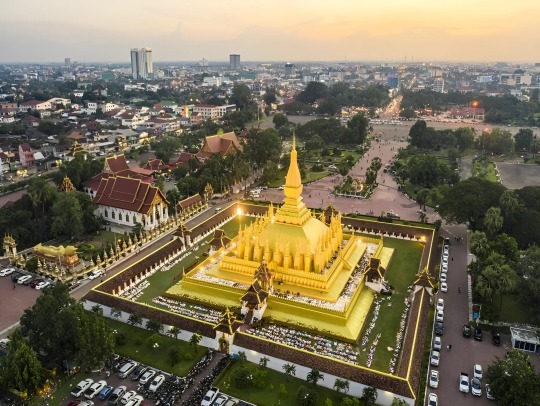
1. Taj Mahal, Agra:
One of the most iconic landmarks in the world, the Taj Mahal is a white marble mausoleum built by Mughal Emperor Shah Jahan in memory of his wife Mumtaz Mahal. Its beauty is unmatched, especially during sunrise and sunset.
Also Read: Kazakhstan tour package
2. Agra Fort, Agra:
A UNESCO World Heritage Site, Agra Fort is a massive red sandstone fort built by Emperor Akbar in the 16th century. It offers panoramic views of the Taj Mahal and houses several palaces, mosques, and gardens.
Also Read: Armenia tour package
3. Amber Fort, Jaipur:
Also known as Amer Fort, this majestic fort is located in Jaipur, Rajasthan. Built with red sandstone and marble, it overlooks Maota Lake and features stunning architecture, including the Sheesh Mahal (Mirror Palace).
Also Read: Georgia package
4. Hawa Mahal, Jaipur:
Translating to "Palace of Winds," Hawa Mahal is a unique five-story palace with a façade adorned with intricate latticework. Built in 1799 by Maharaja Sawai Pratap Singh, it allowed royal ladies to observe street festivals without being seen.
Also Read: Maldives tour package
5. City Palace, Jaipur:
This grand palace complex in the heart of Jaipur showcases a blend of Rajasthani and Mughal architectural styles. It houses museums, courtyards, gardens, and the Chandra Mahal and Mubarak Mahal.
Also Read: Sri Lanka tour
6. Qutub Minar, Delhi:
The tallest brick minaret in the world, Qutub Minar is a UNESCO World Heritage Site located in Delhi. Built in the 12th century by Qutb-ud-din Aibak, it is surrounded by several historically significant monuments.
Also Read: Hongkong tour
7. Humayun's Tomb, Delhi:
Another UNESCO World Heritage Site, Humayun's Tomb is the tomb of the Mughal Emperor Humayun. Built-in the 16th century, it is known for its Persian-inspired architecture and lush gardens.
Also Read: Hyderabad trip
8. Lotus Temple, Delhi:
Shaped like a lotus flower, this Bahá'í House of Worship is one of Delhi's most recognizable landmarks. It welcomes people of all religions to pray or meditate in its serene surroundings.
Also Read: Europe tour package
Conclusion
Embark on a mesmerizing journey through India's Golden Triangle tour, discovering its 8 breathtaking gems. From the majestic Taj Mahal to the vibrant streets of Jaipur, each destination enchants with its rich history and cultural splendor. Explore, immerse, and let the Golden Triangle weave unforgettable memories of beauty and wonder.
0 notes
Text
Top 10 Places to Visit in Delhi
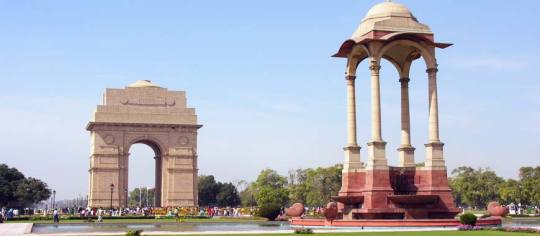
Delhi, the capital city of India, is a fascinating blend of rich history, vibrant culture, and modern development. With its diverse attractions, Delhi offers a myriad of experiences for every type of traveler. Whether you are a history enthusiast, a food lover, or someone seeking spiritual tranquility, Delhi has something for everyone. A tourist visiting the national capital of India must explore the top 10 places to visit in Delhi, each offering a unique glimpse into the city's multifaceted charm.
Red Fort (Lal Qila): The iconic Red Fort, a UNESCO World Heritage Site, stands as a majestic symbol of India's rich past. Built by the Mughal Emperor Shah Jahan in the 17th century, this colossal red sandstone fortress served as the main residence for Mughal emperors for nearly 200 years. The intricate architecture, including Diwan-i-Aam and Diwan-i-Khas, reflects the grandeur of the Mughal era. A visit to the Red Fort is a journey through history, with its stunning structures and well-maintained gardens.
Qutub Minar: Qutub Minar, another UNESCO World Heritage Site, is the world's tallest brick minaret and an exemplary masterpiece of Indo-Islamic architecture. Built in the early 13th century by Qutub-ud-din Aibak, the first ruler of the Delhi Sultanate, the minar is surrounded by ancient ruins, including the Quwwat-ul-Islam Mosque. The intricate carvings on the minaret and surrounding structures make it a must-visit for history and architecture enthusiasts.
India Gate: India Gate, an iconic war memorial, honors the soldiers who sacrificed their lives during World War I. This majestic arch stands at the heart of New Delhi and is surrounded by lush lawns, making it a popular spot for picnics and evening strolls. The Amar Jawan Jyoti, an eternal flame, burns in memory of the unknown soldiers, adding a solemn touch to the impressive structure.
Humayun's Tomb: Humayun's Tomb, another UNESCO World Heritage Site, is a stunning example of Mughal architecture and a precursor to the Taj Mahal. Built in the mid-16th century, this tomb is the final resting place of the Mughal Emperor Humayun. The symmetrical garden layout, intricate lattice work, and use of red sandstone showcase the Mughal aesthetic at its peak, making it a serene and visually captivating destination.
Lotus Temple: The Lotus Temple, a Bahá'í House of Worship, is renowned for its distinctive lotus-shaped architecture and its message of unity and peace. Surrounded by lush gardens, the temple is open to people of all faiths and beliefs, providing a tranquil space for meditation and contemplation. The architectural marvel and the serene atmosphere make the Lotus Temple a unique and spiritually enriching experience.
Akshardham Temple: Akshardham Temple, a relatively modern marvel, is a sprawling complex dedicated to showcasing Indian art, culture, and spirituality. The intricately carved central monument, surrounded by the Yagnapurush Kund, reflects traditional Indian craftsmanship. The Sahaj Anand Water Show and the cultural boat ride are must-see attractions within the complex, offering a multimedia and immersive experience.
Jama Masjid: Jama Masjid, one of the largest mosques in India, is an architectural marvel built by the Mughal Emperor Shah Jahan. Completed in 1656, the mosque's grand courtyard can accommodate thousands of worshippers. Climbing the minaret provides a breathtaking panoramic view of Old Delhi, offering a glimpse into the city's historical and cultural tapestry.
National Museum: For those interested in India's rich cultural heritage, the National Museum is a treasure trove of artifacts spanning over 5,000 years. The museum houses a vast collection of sculptures, paintings, decorative arts, and archaeological finds, providing a comprehensive overview of India's artistic and cultural evolution. From ancient civilizations to modern art, the National Museum offers a fascinating journey through time.
Gurudwara Bangla Sahib: A spiritual oasis in the heart of Delhi, Gurudwara Bangla Sahib is one of the most prominent Sikh shrines. The shimmering Sarovar (pond), the soothing Kirtan (devotional music), and the community kitchen serving free meals (Langar) create a serene and inclusive atmosphere. Visitors of all faiths are welcome, making it a symbol of harmony and unity.
Dilli Haat: Dilli Haat is a vibrant cultural and shopping destination that showcases the diversity of India's handicrafts and cuisine. This open-air market features stalls representing various states, offering a wide array of traditional handicrafts, textiles, and regional delicacies. The lively ambiance, cultural performances, and the opportunity to interact with artisans make Dilli Haat a delightful and immersive experience. Delhi, with its kaleidoscopic blend of history, culture, and modernity, invites travelers to explore its myriad facets. Each of these top 10 places contributes to the city's allure, offering a unique perspective on Delhi's rich tapestry. Whether you are wandering through ancient monuments, savoring diverse cuisines, or finding solace in spiritual havens, Delhi promises a journey of discovery and wonder. Optima Travels offers several Delhi day tour packages.
0 notes
Text
Cobbler Habibullah – Pajhwok Afghan News
https://amzn.to/4ap9nBc
AIBAK (Pajhwok): Habibullah, 40, works as a cobbler at a corner of Aibak City, the capital of northern Samangan province, said that the Eid festival is not for less fortunate and vulnerable people because his biggest dream was to arrange livelihood for his family.
Muslims in the world warmly celebrate Eid-ul-Fitr and Eidul-ul-Adha, in Afghanistan also most people…
View On WordPress
0 notes
Text


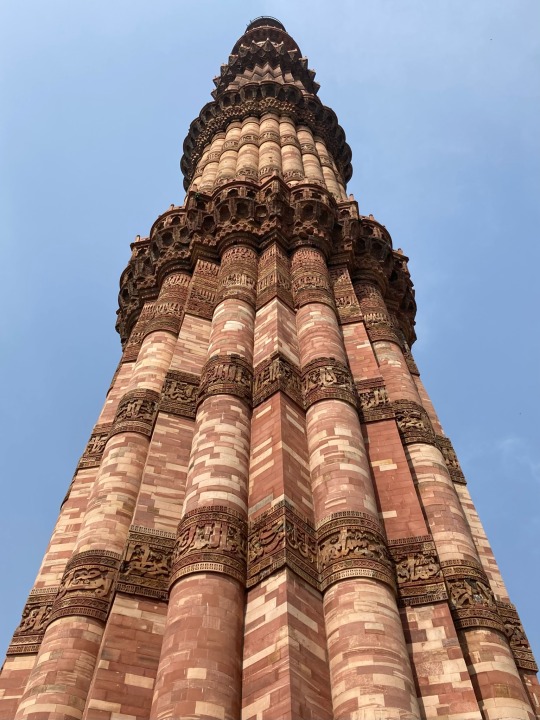
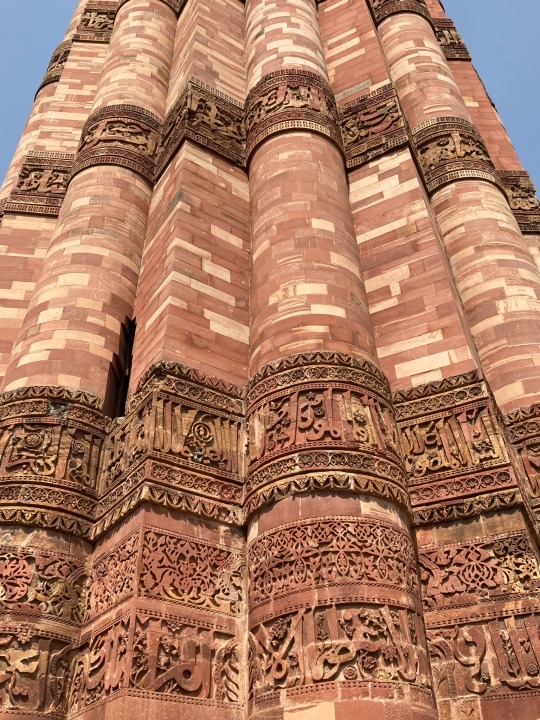

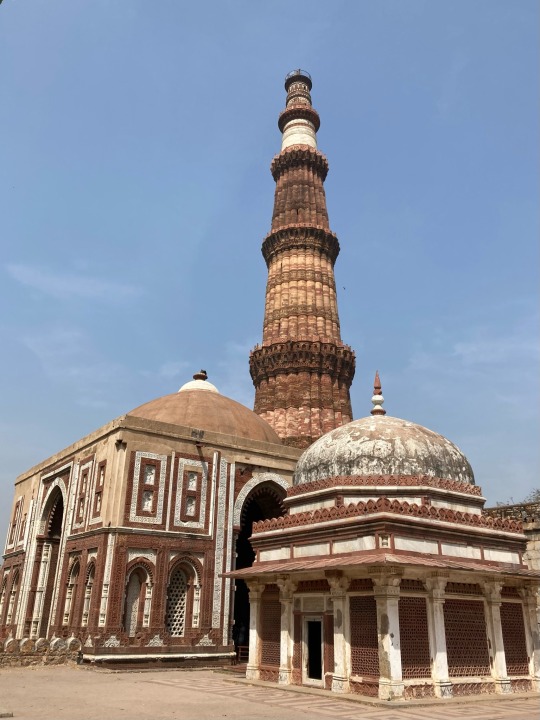

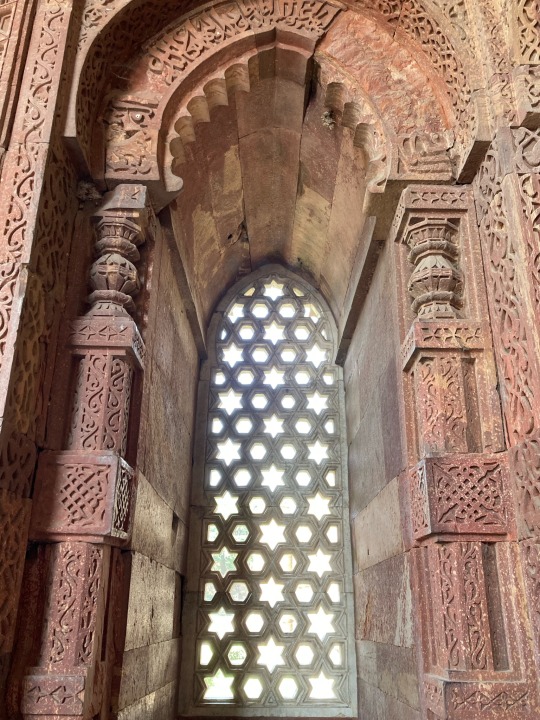


Next stop was the Qutab Minar. The Qutab Minar is a minaret and was part of north India’s first mosque.
The minaret is 238 foot (72.5 metres) tall, and the photographs cannot really show you how high it is.
Construction started in 1199 by Qutb ud-Din Aibak and was completed around 1220 by his son-in-law Iltutmish. The last photograph shows the base for another minaret which was due to be twice the size!
0 notes